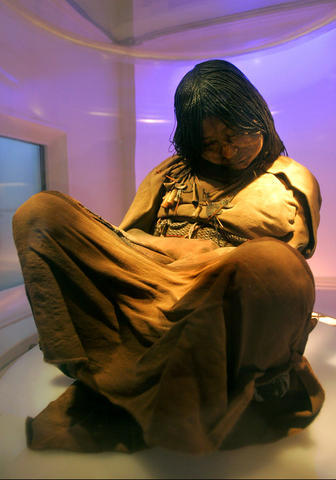Museum-goers gasped on Thursday at the well-preserved mummy of an Incan teenage girl, which is on display for the first time, a serene gaze etched on her face hundreds of years ago when she froze to death in the Andes.
Hundreds of people packed a museum in Salta, Argentina, to see "La Doncella" -- Spanish for "the Maiden" -- a 15-year-old girl whose remains were found in 1999 in an icy pit on Llullaillaco volcano, along with a six-year-old girl and a seven-year-old boy.
Scientists believe the so-called Children of Llullaillaco were sacrificed more than 500 years ago in a ceremony marking the annual corn harvest. Dressed in fine clothes and given corn alcohol to put them to sleep, the victims were then left to die at an elevation of 6,730m.

PHOTO: AP
"Just this morning we have had more than 700 people come see the exhibit, and we had hundreds yesterday when it opened," High Mountain Archaeological Museum director Gabriel Miremont said.
The mummy is kept in a chamber that pumps chilled air through a low-oxygen atmosphere, simulating the subfreezing conditions where it was found. The other two children are being studied and not on display.
Scientists say the girl's face was daubed with red pigment and around her mouth they found flecks of coca leaf, which is chewed by highland Indians to blunt the effects of altitude.
The Children of Llullaillaco were found at the highest elevation ever discovered for sacrificial victims of the former Inca empire.
Several Indian groups waged a losing campaign to prevent the remains from going on display, arguing the mummies should be buried or at least kept from public view.
The exhibit is a "great mistake," said Miguel Suarez, a representative of the Calchaquies valley tribes in and around Salta. He expressed hope visitors would show respect for the dead.
"For us this isn't good," he said.

With much pomp and circumstance, Cairo is today to inaugurate the long-awaited Grand Egyptian Museum (GEM), widely presented as the crowning jewel on authorities’ efforts to overhaul the country’s vital tourism industry. With a panoramic view of the Giza pyramids plateau, the museum houses thousands of artifacts spanning more than 5,000 years of Egyptian antiquity at a whopping cost of more than US$1 billion. More than two decades in the making, the ultra-modern museum anticipates 5 million visitors annually, with never-before-seen relics on display. In the run-up to the grand opening, Egyptian media and official statements have hailed the “historic moment,” describing the

SECRETIVE SECT: Tetsuya Yamagami was said to have held a grudge against the Unification Church for bankrupting his family after his mother donated about ¥100m The gunman accused of killing former Japanese prime minister Shinzo Abe yesterday pleaded guilty, three years after the assassination in broad daylight shocked the world. The slaying forced a reckoning in a nation with little experience of gun violence, and ignited scrutiny of alleged ties between prominent conservative lawmakers and a secretive sect, the Unification Church. “Everything is true,” Tetsuya Yamagami said at a court in the western city of Nara, admitting to murdering the nation’s longest-serving leader in July 2022. The 45-year-old was led into the room by four security officials. When the judge asked him to state his name, Yamagami, who

DEADLY PREDATORS: In New South Wales, smart drumlines — anchored buoys with baited hooks — send an alert when a shark bites, allowing the sharks to be tagged High above Sydney’s beaches, drones seek one of the world’s deadliest predators, scanning for the flick of a tail, the swish of a fin or a shadow slipping through the swell. Australia’s oceans are teeming with sharks, with great whites topping the list of species that might fatally chomp a human. Undeterred, Australians flock to the sea in huge numbers — with a survey last year showing that nearly two-thirds of the population made a total of 650 million coastal visits in a single year. Many beach lovers accept the risks. When a shark killed surfer Mercury Psillakis off a northern Sydney beach last

‘CHILD PORNOGRAPHY’: The doll on Shein’s Web site measure about 80cm in height, and it was holding a teddy bear in a photo published by a daily newspaper France’s anti-fraud unit on Saturday said it had reported Asian e-commerce giant Shein (希音) for selling what it described as “sex dolls with a childlike appearance.” The French Directorate General for Competition, Consumer Affairs and Fraud Control (DGCCRF) said in a statement that the “description and categorization” of the items on Shein’s Web site “make it difficult to doubt the child pornography nature of the content.” Shortly after the statement, Shein announced that the dolls in question had been withdrawn from its platform and that it had launched an internal inquiry. On its Web site, Le Parisien daily published a